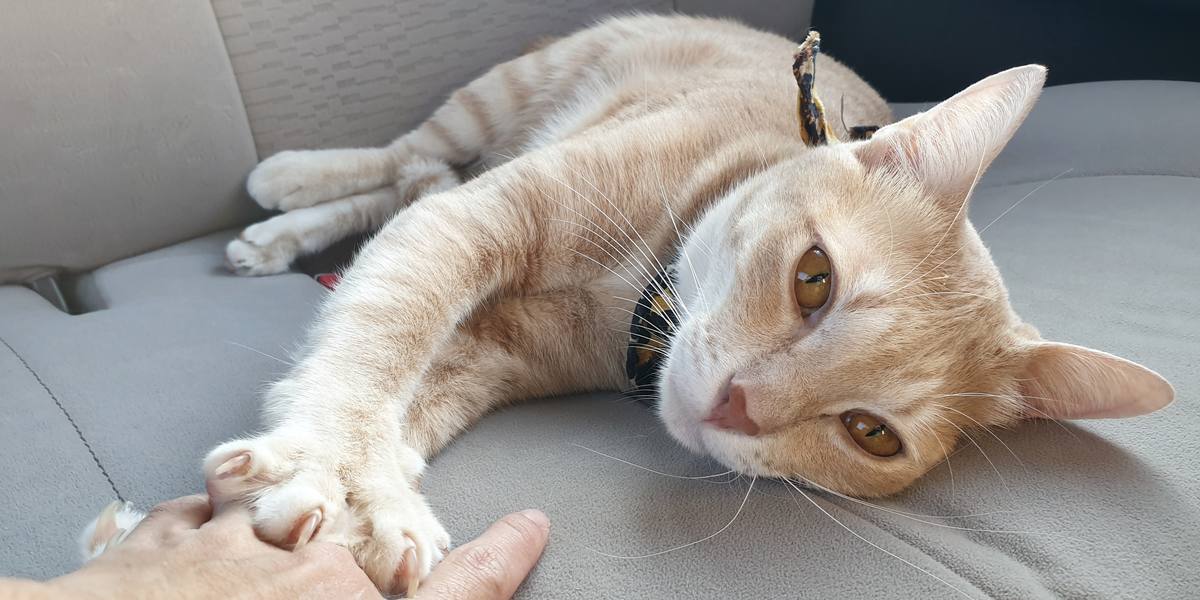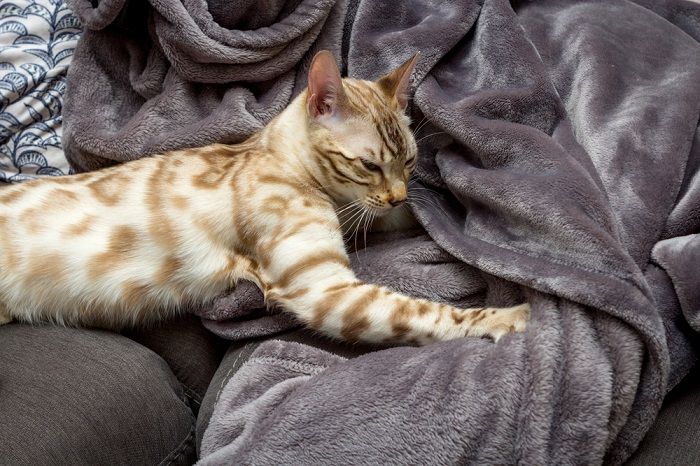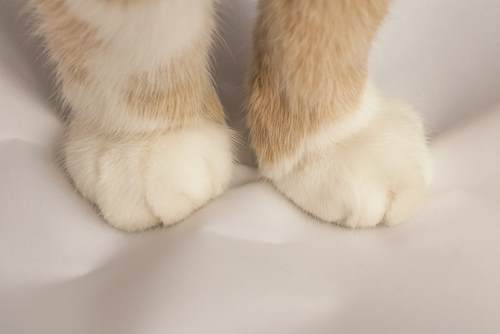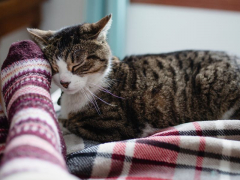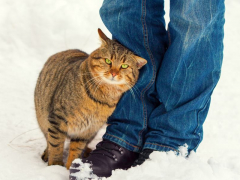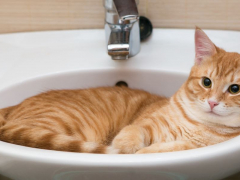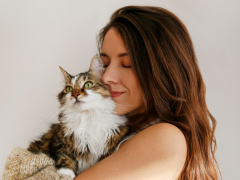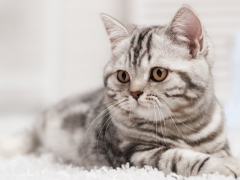Kneading is an adorable cat behavior that many cats display. It involves the rhythmic movement of the front paws pushing out and then pulling back in alternatively.
Key Takeaways
Kneading is a behavior that is leftover from kittenhood, when kittens kneaded with their paws during nursing.
Some cats knead and others don’t, both of which are normal.
If your cat used to knead and now they don’t, have your cat checked out by your vet for any conditions that might be causing pain.
This is affectionately known as “making biscuits” or “kneading bread” as it resembles these movements. It’s a common cat behavior, but that doesn’t mean that all cats knead.
Some cats don’t knead at all and that can be perfectly normal.
What Is Kneading?
First of all, what is kneading? As mentioned above, kneading is a movement that cats make with their limbs and paws. It normally involves the front paws, but sometimes it can involve all four paws.
It’s a rhythmic movement of the paws and limbs stretching out and then retracting back toward the body. It’s an alternating movement (i.e., one paw is stretched out while the other is retracted and then this alternates).
Some cats keep their claws in while they knead; others keep their claws out, which can be a little bit uncomfortable if they’re kneading against you. They might also purr loudly while kneading. Cats often knead on their owners or household items (for instance, a soft fleece blanket, cushion, or bedding). Sometimes kneading is accompanied by drooling or the cat may even suck on a soft blanket.
Why Do Cats Knead?
Now that we’ve established what kneading is, why do cats do it? Kneading is a behavior that cats developed in their kittenhood. As young kittens nursing from their mother, they would have kneaded against their mother’s belly during nursing to stimulate the flow of milk.
This kneading behavior would have been rewarded with increased milk flow and feeding, hence a positive and comforting experience for the kitten.
Many kittens and young adults display this behavior as they remember it from their kittenhood. We’ll now discuss why some adult cats still knead.
Why Do Adult Cats Knead?
In kittens, kneading is connected with comfort and closeness with their mother.
Nursing kittens start kneading to increase their mother’s milk flow during nursing. For this reason, it makes sense why kittens and younger cats may be seen kneading as they recently did it as young kittens. But why do some adult cats still do this?
Some kittens continue to knead into their adulthood because kneading as a kitten would have been connected with comfort and closeness with their mother, and they might display kneading when they’re feeling comfortable or secure as an adult. Basically, it could mean that your cat is happy and comfortable in your presence.
There are some other reasons that cats might knead, including:
- Stretching: Cats might make kneading movements as they stretch out their limbs and paws, especially after sleeping or resting.
- Marking: Cats might make kneading movements with their paws to mark their scent (territory). They have scent glands in their paws and they use these to deposit pheromones. Pheromones are a form of chemical message that cats use to communicate with other cats and the world around them.
- Nesting: Certain cats knead when they’re getting comfortable in their bed and making it into a nest.
- Mating: Female cats might knead and raise their pelvis when they’re mating.
Why Doesn’t Your Cat Knead?
There are many reasons to explain why your cat doesn’t knead and it’s nothing to be alarmed about. Many cats don’t knead at all and they’re perfectly happy, contented cats.
One explanation why your cat doesn’t knead is simply that they didn’t continue this behavior from kittenhood to adulthood. They may have performed this behavior as a kitten nursing from their mother and then simply stopped doing this as they were weaned and had no further use for it. It doesn’t mean that they’re unhappy or insecure; it’s just that they don’t feel the need to do this.
Other reasons that might explain why your cat doesn’t knead are:
- Early kitten care: If there was interference in their normal kitten development (e.g., fed from their mother versus hand reared with a bottle by a human).
- Insecure or not settled in their environment: For example, a new cat in the house might not feel comfortable enough yet to knead and shows signs of ease and comfort.
- Stress: If a cat is stressed they may not display any positive body language signs like kneading. In contrast, a small amount of cats might knead to comfort themselves in times of stress so it’s important to observe the environment that the cat is in and monitor for other signs of stress (hiding, less interactive, toileting inappropriately, changes in appetite and weight, vocalizations, etc.).
- Medical reasons: Cats that suffer from osteoarthritis or nail bed disease might find the kneading motions painful so you might notice that they don’t display this behavior.
If you’re unsure if your cat is in pain or feeling stressed, schedule a consultation with your veterinarian. They will perform an examination and check for any signs of pain or illness that might be affecting your cat. They can discuss signs of stress and how to remedy this if stress is present.
It’s very possible that your cat isn’t kneading due to the first and main reason, which is that they didn’t carry on doing this behavior after they developed into an adult cat.
This doesn’t mean that they don’t enjoy their life or love you; it simply means they don’t feel the need to display this behavior. And that’s OK because every cat is unique and different, and they all show affection in their own ways.
If Your Cat’s Kneading Is Uncomfortable
Some cats knead on their owners laps with their claws out and their nails can dig into you. This can be quite uncomfortable. If your cat is doing this, it’s important to never punish them for this as they don’t realize that they’re hurting you. If they’re an indoor cat, you can clip the tips of their nails and this should reduce the discomfort.
You can learn how to do this yourself or bring them to a cat groomer or your veterinary clinic. I wouldn’t recommend clipping the nails of a cat that goes outdoors as they need their nails for climbing and for defending themselves.
Another option would be placing a thick blanket on your lap that protects you from your cat’s nails. This will create a barrier and should make kneading more comfortable. The use of synthetic pheromone sprays applied to the blanket, will encourage your cat to knead on the blanket instead of you.
Final Thoughts
Cats might knead on your lap or on a blanket or other soft surface.
By now you know everything that you need to know about kneading and why cats do or don’t display this behavior. It’s important to remember that not all cats knead and that this could be perfectly normal for your cat. As we know, all cats are unique and have their own personalities, so it makes sense that they don’t all act the same.
However, in some cases, particularly if they used to knead and now they don’t, it’s recommended to get your cat checked out by your vet for any conditions that might be causing pain and preventing your cat from kneading. Watch out for kneading behavior the next time you’re around a cat and take it as a compliment!
Frequently Asked Questions
Is it normal for cats not to knead?
Yes, it’s perfectly normal. Some cats knead and others don’t, both of which are normal. Cats learn how to knead as young kittens while nursing. Some continue this as a comforting and happy sign as adults.
How do I get my cat to knead?
If your cat doesn’t knead already, it might be that they don’t perform this behavior and this is normal. If they’re a new cat, give them time to settle into their new home before expecting to see them kneading. Otherwise, check for signs of stress or pain that might be preventing them from kneading.
Why does my cat not rub against me?
Some cats do this and others don’t, it doesn’t mean that your cat doesn’t like you. It simply means that they don’t feel the need to perform this behavior. They might be displaying affection toward you in other ways.
At what age do cats start kneading?
Cats start kneading from a young age, even as young as 2 weeks of age. They knead during nursing to stimulate their mother’s milk flow.
